For some time now, I’ve been experimenting with projecting animated text onto mirrors – either with small flexible mirrors that allow the projection to be distorted and moved around a space, or with large mirror panels to create an immersive illusion of spaces that open up and disappear. Most recently, I worked with Teater Interakt in Malmö on part of a big interactive theatre city tour, Ingen Ingen FråganFrågan, and now I’ve taken some time to reflect on my journey with mirrors.
| My experiments began in 2007 in Brisbane when working with Suzon Fuks and James Cunningham, and a piece of flexible perspex. Here’s a short recording from that workshop. Following this discovery of the wonders of flexible mirrors, I had a piece of perspex cut to fit into my suitcase, and set about using it at every opportunity. |
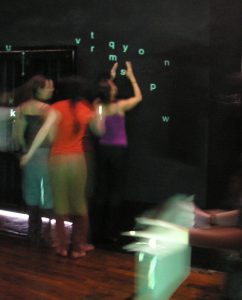 For example soon after, at the Magdalena Sin Fronteras festival (Cuba, 2008), I used my flexible mirror to rain letters on the performers in the collaborative performance Women with Big Eyes. At the SCANZ Symposium in New Plymouth, February 2009, I used it in the online-offline performative presentation Enacting Collective Intelligence and in July of the same year at Machine Divas in Vienna. And there were other times – I was always carefully packing my oblong of mirror, painted white on the back for a non-reflective projection surface, into my suitcase.
For example soon after, at the Magdalena Sin Fronteras festival (Cuba, 2008), I used my flexible mirror to rain letters on the performers in the collaborative performance Women with Big Eyes. At the SCANZ Symposium in New Plymouth, February 2009, I used it in the online-offline performative presentation Enacting Collective Intelligence and in July of the same year at Machine Divas in Vienna. And there were other times – I was always carefully packing my oblong of mirror, painted white on the back for a non-reflective projection surface, into my suitcase.
Then in 2010 I was invited to Graz, Austria to collaborate with the artists’ collective Schaumbad on an UpStage project. While we were working on the cyberformance in Schaumbad’s large former industrial building, I noticed a number of big mirror foil panels leaning against a wall. I learned that they had been salvaged from an exhibition and were waiting for someone to do something with them. So we did! Working with Eva Ursprung and other artists who we roped in to help, we lined a corner of the open space with the mirrors and hung black curtains to achieve a blackout. I then took a recipe for bean salad, given to me by one of the artists helping us, and made a text animation which I projected into the mirrors. Another of the artists made a voice recording of the recipe. The resulting installation was a beautiful shifting space, with voids opening and closing as the text changed and a gentle voice-over reciting the recipe. We placed some beanbags and cushions on the floor and people stayed in the space for a long time, immersed in it.
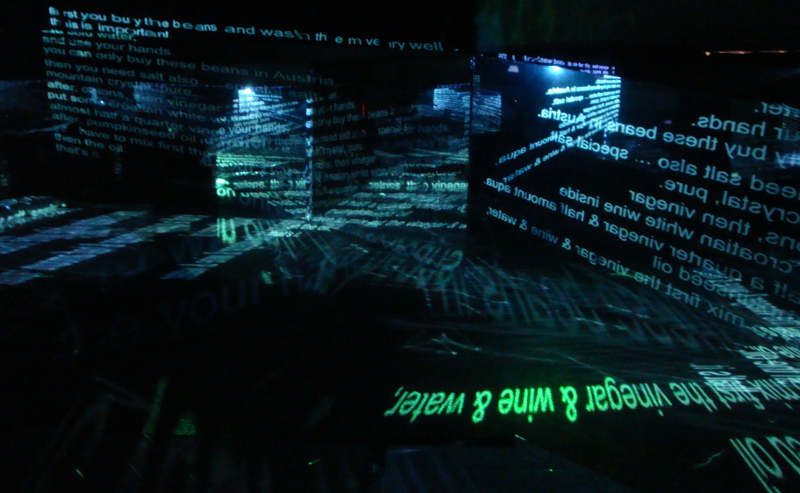
My work is mostly live performance, temporal and ephemeral, and much of it is online so even more ephemeral than “real life” theatre performances. The only traces are digital, and they disappear quickly. Mirrors are similar – the result is extremely hard to capture with photos or videos, and with large mirrors I have only been able to create these installations almost by chance – and such chances don’t come very often. My next opportunity did not come until six years later, and again a series of chances led to it.
The singer Helen Chadwick has a wonderful album and solo performance, Fragments of Love, featuring songs she has created from the fragments of Sappho’s love poetry. In these songs, Helen layers her live voice over recordings of her own voice, creating an audio palimpsest of words and voice. When I listened to this, it reminded me of the effect of the large mirrors, where texts layered over each other, together and in virtual distance, creating layers of echoes. I was inspired to create another mirror installation, this time with Helen’s music. She gave me permission to do so, and then in conversation with the scenographer Antonella Diana, I learned that Odin Teatret in Denmark had mirror foil panels from their performance Andersen’s Dream. As I would be at the Odin for the Transit Festival in 2016, I asked if it was possible to use the mirrors, and the answer came back: yes. However a suitable space at the theatre was not possible; in the end, space was found at Holstebro’s former Slagterei – the slaughter house which had been vacated a couple of years before. The first time I entered this space I felt chilled to the bone: the air was heavy and cold, laced with traces of the terror of thousands of doomed animals. I burned sage, sprinkled salt and water, and Suzon came and did a reiki cleansing. The energy began to shift.
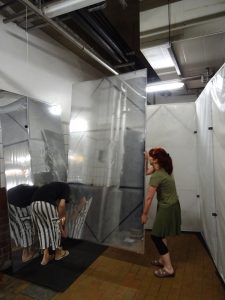 Before the festival, I’d prepared a series of text animations to go with Helen’s songs. I used Blender, an open source 3D animation software – somewhat overkill as I really only needed 2D animation, but it was interesting to learn a bit about how it worked, and I was quite happy with what I was able to achieve. But it was impossible for me to properly try out how they would work in the mirrors, beyond some small experiments in the bathroom, so I had to do a lot of guessing and hoping. With the help of some Odin technicians and festival participants (Gutto Bazzo and Maria Porter) we set up the mirrors in a corner of a large open space at the Slagterei. In Andersen’s Dream, the mirrors had been hung to form a ceiling above the performance; now I needed them to stand up as walls. Odin tech Thomas built wooden legs behind the mirror’s frames, and we held everything together with clamps. It was quite a mission to get the space blacked out, the mirrors arranged and everything ready in time for the public to come – and then also a mission to get all of the festival participants in and out of the installation in the limited time that we had, as they had to be transported with vans from the theatre to the Slagterei and back to continue with the intense festival programme.
Before the festival, I’d prepared a series of text animations to go with Helen’s songs. I used Blender, an open source 3D animation software – somewhat overkill as I really only needed 2D animation, but it was interesting to learn a bit about how it worked, and I was quite happy with what I was able to achieve. But it was impossible for me to properly try out how they would work in the mirrors, beyond some small experiments in the bathroom, so I had to do a lot of guessing and hoping. With the help of some Odin technicians and festival participants (Gutto Bazzo and Maria Porter) we set up the mirrors in a corner of a large open space at the Slagterei. In Andersen’s Dream, the mirrors had been hung to form a ceiling above the performance; now I needed them to stand up as walls. Odin tech Thomas built wooden legs behind the mirror’s frames, and we held everything together with clamps. It was quite a mission to get the space blacked out, the mirrors arranged and everything ready in time for the public to come – and then also a mission to get all of the festival participants in and out of the installation in the limited time that we had, as they had to be transported with vans from the theatre to the Slagterei and back to continue with the intense festival programme.
The installation functioned well in the Slagterei. We were able to place the speakers a distance from the enclosed space of the mirrors, helping to create the sense of a large and shifting space, and the acoustic was very good. By the end of the run, there was a palpable change in the energy of the space – the air felt warmer, cleaner. Helen’s beautiful voice, Sappho’s poetry and the visuals of text and reflections had worked a kind of magic in a space that had seen the deaths of so many creatures.
What was not so good, unfortunately, was the quality of the mirrors: they were some years old, and the foil (actually a kind of plastic, I think) had begun to stretch a little, creating ripples in some of the mirrors that affected the reflections. The metallic coating that produced the mirror effect was also deteriorating, leaving tiny white dots everywhere that were not reflective. So the reflections were not as sharp and vivid as those in the installation at Schaumbad where the mirrors were in very good condition.
Last year Teater Interakt asked me to collaborate on a project with them, to create a similar mirror installation this time with material from their research into migration to Malmö. It was to be in a room in the old castle, now part of the Malmö Museum, which at about 12 square metres was quite a bit smaller than the previous spaces I’d done this . We started to research the cost of buying enough foil mirrors to line the space and quickly discovered just how expensive it can be, and how many different options there are – foil or plexiglass, real glass, different thicknesses, and so on. I contacted the Odin to see if we could borrow their mirrors, but after another two years in storage the foil had deteriorated even more. By chance I discussed the problem with a friend and colleague who she had worked with stainless steel mirrors and asked, had we considered steel? We hadn’t, so we did, and discovered that not only would this work out cheaper than any other material, it would also probably be more durable. So we went for the steel.
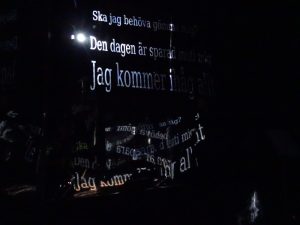 The challenges then came with the room. Steel is of course quite heavy, and the room at the museum was upstairs with no lift access; six 2 x 1.25 metre panels weighing about 20 kilos each had to be carried up stairs, around narrow corners and into the room, as well as several smaller steel panels and two larger perspex panels. As it is an historic building, we were not allowed to attach anything to the walls, only hanging from the ceiling. Furthermore we were only allowed to work in the museum during its opening hours, which meant we were working amongst the public. This brought back memories of my previous experiences setting up interactive digital installations in public libraries in Denmark and in the UK, with all the attendant safety and security issues that add another layer of complexity to the work. Happily I was working with the video artist Manel Ruiz Blas whose many talents include creative problem solving, wielding an electric drill and speaking fluent Swedish. Due to having so many practical issues to deal with, we had less time than I had hoped for the actual content creation; however in the end with a few late nights we managed to get it all done and the performance ran successfully over four weeks during March and April 2019. The installation, which was just one part of a three-hour performance journey across the city, will be presented again at the Transit Festival this coming June.
The challenges then came with the room. Steel is of course quite heavy, and the room at the museum was upstairs with no lift access; six 2 x 1.25 metre panels weighing about 20 kilos each had to be carried up stairs, around narrow corners and into the room, as well as several smaller steel panels and two larger perspex panels. As it is an historic building, we were not allowed to attach anything to the walls, only hanging from the ceiling. Furthermore we were only allowed to work in the museum during its opening hours, which meant we were working amongst the public. This brought back memories of my previous experiences setting up interactive digital installations in public libraries in Denmark and in the UK, with all the attendant safety and security issues that add another layer of complexity to the work. Happily I was working with the video artist Manel Ruiz Blas whose many talents include creative problem solving, wielding an electric drill and speaking fluent Swedish. Due to having so many practical issues to deal with, we had less time than I had hoped for the actual content creation; however in the end with a few late nights we managed to get it all done and the performance ran successfully over four weeks during March and April 2019. The installation, which was just one part of a three-hour performance journey across the city, will be presented again at the Transit Festival this coming June.
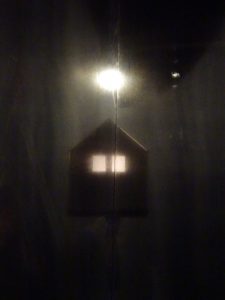 In projects such as these and in my cyberformance work, technical and practical challenges often dominate the process and sometimes threaten to overshadow the creative work. But everything is interdependent and often a technical limitation will lead to an unexpected creative solution, or a practical problem will resolve itself through an artistic idea. I always try to find solutions that serve both the practical and artistic aspects of the project. If we are given a space that’s far from ideal, what are the new opportunities that the space brings? If our budget is too small, what can we achieve within the resources that we have? If the creative ideas are stuck, can we rearrange the practical elements to loosen things up?
In projects such as these and in my cyberformance work, technical and practical challenges often dominate the process and sometimes threaten to overshadow the creative work. But everything is interdependent and often a technical limitation will lead to an unexpected creative solution, or a practical problem will resolve itself through an artistic idea. I always try to find solutions that serve both the practical and artistic aspects of the project. If we are given a space that’s far from ideal, what are the new opportunities that the space brings? If our budget is too small, what can we achieve within the resources that we have? If the creative ideas are stuck, can we rearrange the practical elements to loosen things up?
In the mirror installations, I want to experience immersion in a shifting space, where solid walls become openings to new architectures, virtual spaces of the imagination. I want to see through the looking glass, through the surface of the text to other stories and meanings behind, and be surprised by it. I want to see myself in the text, the text on my body, my body in other magical spaces that are created by words, thoughts, meaning. Each time I find the chance to do it, I experience these things in fleeting moments. Each time I explore this transient territory a little further, find new surprises.